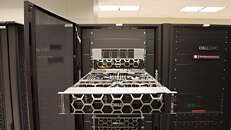- Joined
- Oct 9, 2007
- Messages
- 47,895 (7.38/day)
- Location
- Dublin, Ireland
| System Name | RBMK-1000 |
|---|---|
| Processor | AMD Ryzen 7 5700G |
| Motherboard | Gigabyte B550 AORUS Elite V2 |
| Cooling | DeepCool Gammax L240 V2 |
| Memory | 2x 16GB DDR4-3200 |
| Video Card(s) | Galax RTX 4070 Ti EX |
| Storage | Samsung 990 1TB |
| Display(s) | BenQ 1440p 60 Hz 27-inch |
| Case | Corsair Carbide 100R |
| Audio Device(s) | ASUS SupremeFX S1220A |
| Power Supply | Cooler Master MWE Gold 650W |
| Mouse | ASUS ROG Strix Impact |
| Keyboard | Gamdias Hermes E2 |
| Software | Windows 11 Pro |
A collaboration including Intel, Dell Technologies, Nvidia and the Ohio Supercomputer Center (OSC), today introduces Cardinal, a cutting-edge high-performance computing (HPC) cluster. Purpose-built to meet the increasing demand for HPC resources in Ohio across research, education and industry innovation, particularly in artificial intelligence (AI).
AI and machine learning are integral tools in scientific, engineering and biomedical fields for solving complex research inquiries. As these technologies continue to demonstrate efficacy, academic domains such as agricultural sciences, architecture and social studies are embracing their potential. Cardinal is equipped with the hardware capable of meeting the demands of expanding AI workloads. In both capabilities and capacity, the new cluster will be a substantial upgrade from the system it will replace, the Owens Cluster launched in 2016.


The Cardinal Cluster is a heterogeneous system featuring Dell PowerEdge servers and the Intel Xeon CPU Max Series with high bandwidth memory (HBM) as the foundation to efficiently manage memory-bound HPC and AI workloads while fostering programmability, portability and ecosystem adoption. The system will have:
The system is also equipped with:
View at TechPowerUp Main Site
AI and machine learning are integral tools in scientific, engineering and biomedical fields for solving complex research inquiries. As these technologies continue to demonstrate efficacy, academic domains such as agricultural sciences, architecture and social studies are embracing their potential. Cardinal is equipped with the hardware capable of meeting the demands of expanding AI workloads. In both capabilities and capacity, the new cluster will be a substantial upgrade from the system it will replace, the Owens Cluster launched in 2016.


The Cardinal Cluster is a heterogeneous system featuring Dell PowerEdge servers and the Intel Xeon CPU Max Series with high bandwidth memory (HBM) as the foundation to efficiently manage memory-bound HPC and AI workloads while fostering programmability, portability and ecosystem adoption. The system will have:
- 756 Max Series CPU 9470 processors, which will provide 39,312 total CPU cores.
- 128 gigabytes (GB) HBM2E and 512 GB of DDR5 memory per node.
The system is also equipped with:
- Thirty-two nodes that will have 104 cores, 1 terabyte (TB) of memory and four Nvidia Hopper architecture-based H100 Tensor Core GPUs with 94 GB HBM2E memory interconnected by four NVLink connections.
- NVIDIA Quantum-2 InfiniBand, which provides 400 gigabits per second (Gbps) of networking performance with low latency to deliver 500 petaflops of peak AI performance (FP8 Tensor Core, with sparsity) for large AI-driven scientific applications.
- Sixteen nodes that will have 104 cores, 128 GB HBM2E and 2 TB DDR5 memory for large symmetric multiprocessing (SMP) style jobs.
View at TechPowerUp Main Site
